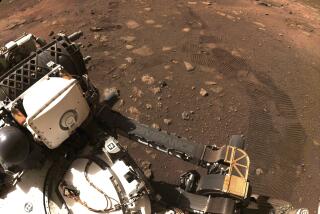‘Destination Mars’ Takes Uneven Trip
The producers of “Destination Mars” were probably the happiest people on the planet last summer when scientists made the stunning announcement of a rock containing possible remnants of life on Mars.
Talk about your great timing. Steven Spielberg himself might not have been more ecstatic had a live dinosaur been discovered during the filming of “Jurassic Park.”
With Mars now on everyone’s minds, the two-hour “Destination” on the Discovery Channel on Sunday seems assured a good-sized audience. Unfortunately, the TV docu-fantasy does not often match the real-life drama surrounding that 16-million-year-old rock found in Antarctica.
While the documentary portion of the production is well worth watching, it is dragged down by the pretend mission of four astronauts to the Red Planet, which seems to cull the dullest outtakes of a remake of “2001: A Space Odyssey.”
Where the production does generate some excitement is in its depiction of actual research on how to fuel the rockets and feed the crews that might someday check out this Martian life thing in person. If the thought of recycling urine as drinking water doesn’t bother you, then you should be impressed at the ingenuity of scientists floating their self-sustaining, flying greenhouse idea.
Here’s how it works: Plants packed leaf by leaf gobble up the carbon dioxide exhaled by the astronauts, then in turn use it to manufacture enough oxygen to sustain the crew. As for fuel, the plan is to combine gases in the Martian atmosphere with hydrogen brought from Earth to fill the tanks for the crucial return flight home. That fueling process could take five to 10 months, but they will wash the windows and check the tires while you wait.
Perhaps the most intriguing unknown factor in this projected 2 1/2-year round-trip journey is the psychological resilience of the crew. Primarily because of their experience with the Mir space station, the Russians are far more knowledgeable than Americans in this area.
In the show’s most eerie segment, we see a prospective cosmonaut spend 10 days in an isolated chamber, the first three of which are sleepless. The scene is reminiscent of the famous “Twilight Zone” episode, some 35 years earlier, in which actor Earl Holliman believes he is the last man on Earth until it is revealed he is actually an astronaut hallucinating in an isolation training chamber.
Finally, “Destination Mars” delivers the punch line on how we humans will eventually make Mars’ atmosphere Earth-like enough for our descendants: We will warm the Martian surface--causing carbon dioxide to rise--by polluting the living heck out of it with CFCs and other assorted greenhouse industrial gases.
Now that’s do-able.
* “Destination Mars” airs from 8-10 p.m. Sunday on Discovery Channel.
More to Read
The complete guide to home viewing
Get Screen Gab for everything about the TV shows and streaming movies everyone’s talking about.
You may occasionally receive promotional content from the Los Angeles Times.






